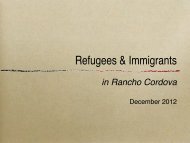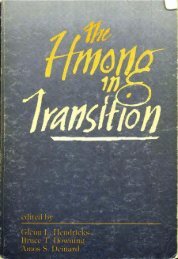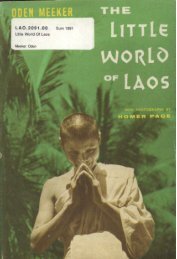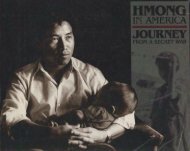PEOPLE
Grant, The Boat People - Refugee Educators' Network
Grant, The Boat People - Refugee Educators' Network
- No tags were found...
Create successful ePaper yourself
Turn your PDF publications into a flip-book with our unique Google optimized e-Paper software.
formulate any opinion beyond 'we are so happy to bc here'. Sweden<br />
has a good record with immigrants, who enjoy most of the righm<br />
Swedcs have, including, after three years, voting rights in lwal elmtions.<br />
The first intimation that Sweden would take in boat people came<br />
from the king, Carl XVI Gustaf, when he pdd a twday visit to<br />
Geneva, on 5 Dccember 1978. He told a press conference that the<br />
Swedish prliamcnt was considering the refugte problem and might<br />
agree to take some 2000 refugees - but he hastened to add tbt he<br />
had no authority to make a decision himself. By the beginning of<br />
1979 there was still no decision by the parliament. But by now<br />
Sweden was under mounting intemational pressure to take her quota<br />
of bat peoplc. Foreign Minister Hans Blix admitted the Vietnam=<br />
refugee situation was difficult and wid every nation must contribute<br />
in its own way to a solution.<br />
There wu speculation that Sweden's delay was caud by her<br />
special relationship with Viemm. During the Vietnam war Sweden<br />
was one of the few western netions that recognized Hanoi and broke<br />
off diplomatic relations with Saigon. Then, whtn the war endad,<br />
Vietnam became one of the largest recipients of Swedish foreign aid.<br />
Aid in 1978-79 stood at 380 million kronor ($88.3 million) and in<br />
1979-80 it will rise to 400 million kronor ($93 million). By 12 January<br />
1979, international pressure and the worsening situation in<br />
South-East Asia proved too much, In a rpecial exm wssion of the<br />
&net, just before kime Minister Ola Ullsten was due to leave for<br />
a two-week visit to the United Seates, the government agreed to<br />
accept 250 boat people. Immigration Minister Eva Winther admitted<br />
that this was largely a token gesture, &signed to encourage 0thcountries<br />
to ampt their humanitarian responsibilities for the refugee<br />
problem in South-East Asia.<br />
On 21 June Sweden announced it was doubling its refugee intake<br />
for 1979, as a direct result of the worsening situation in South-East<br />
Asia. The refugee quota was increased to 2500, with an estimated<br />
1250 rcfugecs from Vietnam. It was also ~nnounced that Sweden<br />
would give 15 million kronor ($3.4 million) to the United Nations<br />
campaign to aid refuges in South-East Asia, Blix emphasized that<br />
Swedish aid to Vietnam would continue. The aid was for long-term<br />
proiects like hospitnls and a lumber mill and should not be used to<br />
influence the short-term decisions of the Vietnamese government,<br />
However, with repons that Viemam was openly encouraging ethnic<br />
Chinese to leave tht country, criticism of the aid progmm<br />
mounted. In the parliament the diwontcnr was voiced by Bertil<br />
FiskesjB, of the Centre Party, who said all new aid to Viemam should<br />
be stopped. 'It is completely fanustic that, whtn a dgirne is epsting<br />
out a large pm of its population to possible death and an uncermin<br />
fate, Swcden should continue to give large sums in aid to the country<br />
in question,' he said. Meanwhile Prime Minister Ullsten revealed<br />
that he had made repeated appeals to Vietnam's premier, Phm Van<br />
Dong, to rake steps to else the situation. Opposition leader Olof<br />
l'alme, who in 1968 marched alongside Hanoi's ambassador in a<br />
Stockholm suet demonstration against Ameriean involvement in<br />
Vietnam, rcvcaled that he too had made appeals to Pham Van Dong.<br />
Of the other Sandinavian counwits, Norway has agreed to We<br />
3000 boat people h t by late 1979 only 200 had arrived. They were<br />
being housed in apartmmts in three main ccnms: Oslo, the capital,<br />
Bcrgm mnd Hamar. There they arc given fm language tuition, full<br />
sucial help and assisrance in obtaining work. Finland has taken a<br />
hundred boat people. They have been accommodartd in apments<br />
in Korso, near Helsinlu, and there they also get all social benefits,<br />
free language tuition and help in gcning a job. Finland took refugees<br />
regardlea of their professional status and qualifications. When the<br />
first refugees arrived they were a bit alarmed to learn that Russia<br />
was so close, and even more surprised to learn that there wcrecommunists<br />
in Finland.<br />
iC'ezu Zea knd<br />
Far from the world's trouble sputs, New Zealand has ncver had to<br />
face the problem of refugees arriving empty-handed on its shores.<br />
Although New Zealandcrs have often showed a high degree of compussion,<br />
relatively few refugees have sought o haven there. Since<br />
1944, when a first group of 840 Poles arrived in New Zealand, fewer<br />
than 10 OM rcfugets have been taken in by a population that now<br />
nurnkrs 3,1, million. Thc largest group was 4500 European refugees<br />
after the semnd world war, followed by 11OO Hung~rians after the<br />
abortive 1956 uprising. However, there has been a surge of public

















